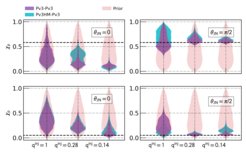When precession and higher harmonics play together
How well can gravitational waves help us extract astrophysical information from precessing black hole binaries?
While several dozens of gravitational-wave signals from coalescing compact binaries – most of them binary black hole systems – have been identified by LIGO and Virgo, no convincing proof of strong orbital plane precession has been found in any of them. A new simulation study by two researchers from AEI Hannover compares how well two different waveform models can extract information about precession from gravitational-wave signals. They show that including higher harmonics in the waveform allows to infer the presence of precession most of the time, while using only the dominant harmonic fails to do so. Moreover, they find that identifying precession improves the measurement of mass and spin parameters. For certain equal mass binaries, the extracted information is biased by the prior assumptions on the precession distribution. Since the Universe will likely contain binary black holes with high spins and strong precession, studies like this one are important to understand how robust the information inferred from their gravitational waves is.
Paper abstract
Gravitational-wave (GW) signals from coalescing compact binaries carry enormous information about the source dynamics and are an excellent tool to probe unknown astrophysics and fundamental physics. Though the updated catalog of compact binary signals reports evidence for slowly spinning systems and unequal mass binaries, the data so far cannot provide convincing proof of strongly precessing binaries. Here, we use the GW inference library parallel Bilby to compare the performance of two waveform models for measuring spin-induced orbital precession. One of the waveform models incorporates both spin-precession effects and sub-dominant harmonics. The other model accounts for precession but only includes the leading harmonic. By simulating signals with varying mass ratios and spins, we find that the waveform model with sub-dominant harmonics enables us to infer the presence of precession in most cases accurately. In contrast, the dominant model often fails to extract enough information to measure precession. In particular, it cannot distinguish a face-on highly precessing binary from a slowly precessing binary system irrespective of the binary's mass ratio. As expected, we see a significant improvement in measuring precession for edge-on binaries. Other intrinsic parameters also become better constrained, indicating that precession effects help break the correlations between mass and spin parameters. However, the precession measurements are prior dominated for equal-mass binaries with face-on orientation, even if we employ waveform model including subdominant harmonics. In this case, doubling the signal-to-noise ratio does not help to reduce these prior induced biases. As we expect detections of highly spinning binary signals with misaligned spin orientations in the future, simulation studies like ours are crucial for understanding the prospects and limitations of GW parameter inferences.













